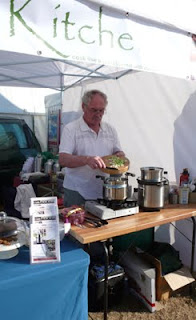 This weekend we had a stand at the Beaulieu Static Caravan Show. The weather was perfect.
This weekend we had a stand at the Beaulieu Static Caravan Show. The weather was perfect. Ingredients
- 2 tbsp olive oil
- 2 onions, finely chopped
- 3 cloves of garlic, chopped finely
- bunch of coriander, leaves picked, stalks chopped up finely
- 2 green chillies, diced finely
- 1 tsp of chilli flakes
- 2 tsp ground cumin
- 2 tsp ground cinnamon
- 2 tsp dried oregano
- 1 kg good-quality beef mince
- 2 tbsp tomato puree
- 200ml red wine
- 1 tsp of salt
- 1 tsp of fresh ground pepper
- 600g canned chopped tomatoes
- 2 tbsp black treacle
- 1 litre beef stock
- 2 red peppers diced
- 400g tin kidney beans
- 1 lime, cut into wedges
Method:
- Heat the olive oil in the inner pot and gently fry the onions, garlic, coriander stalks and chillies on a medium heat for 5 minutes until softened.
- Stir in the spices and oregano and cook for 2 minutes.
- Turn up the heat to medium-high, add the beef mince and brown it.
- Turn down the heat to medium and add the tomato puree and cook for 2 minutes.
- Add the salt, pepper and red wine. Cook it for 2 minutes to let it reduce.
- Stir in the canned tomatoes, peppers, kidney beans and black treacle.
- Put the lid on the inner pot and turn of the heat.
- Put the inner pot into the insulated outer pot and shut the lid.
- Leave to cook in the thermal cooker for a minimum of 2 hours.
- Before serving check the seasoning and adjust.
- Serve with rice and garnish with the coriander leaves.























